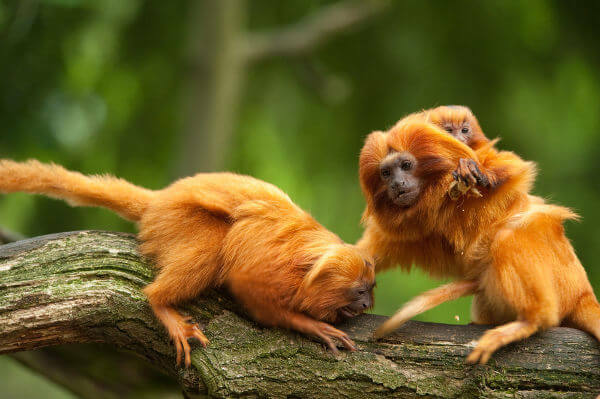THE Atlantic forest it is one of the biomes of Brazil, which occupies approximately 15% of the country's territory.
Currently, due to the destruction of ecosystems (deforestation, fires), only about 7% of the original coverage of this biome remains, consecrated with diverse fauna and flora, including endemic species (they only develop in this location) being considered one of the richest regions in biodiversity of the planet. Also, the animal trafficking it is also considered a threat to the biodiversity of the Atlantic Forest.
To know more: Atlantic forest
Fauna
The Atlantic Forest fauna is very diverse with species of birds, mammals, reptiles, amphibians, insects. There are a large number of animals that only exist in that region, called endemic animals.
Thus, researches claim that in the Atlantic Forest about 40% of mammals are endemic. The main species of animals in the Atlantic Forest are:
birds
- Banana Aracari (Pteroglossus bailloni)
- Caterpillar Saíra (Tangara desmaresti)
- Aracari-poca (Selenidera maculirostris)
- Red-fronted Jandaia (Aratinga auricapillus)
- Tangará (Chiroxiphia caudata)
- Yellow-headed Woodpecker (Celeus flavescens)
- Peacock's Hawk (Spizaetus ornatus)
Mammals
- Golden Lion tamarin (Leontopithecus rosalia)
- Black-faced Lion Tamarin (Leontopithecus caissara)
- Jaguar (Panthera onca)
- Irara (Eira barbara)
- giant anteater (Myrmecophaga tridactyla)
- Furry Armadillo (Euphractus villosus)
- Northern Muriqui (Brachyteles hypoxanthus)
- Margay (Leopardus wiedii)
- Saw marmoset (Callithrixflaviceps)
- Black Hedgehog (Chaetomys subspinasus)
- Wild Rat (Wilfredomys oenax)
In addition to these, there are other emblematic mammals belonging to the Atlantic Forest, such as the capuchin monkey, sloth, capybara, giant armadillo, pampas deer, otter, wild cat, wild dog, Ocelot, howler monkey.
amphibians
- Cane Toad (Rhinella icterica)
- Hammer frog (Hypsiboas faber)
- Green Tree Frog (Phyllomedusa nordestina)
- Phyllomedusa (Phyllomedusa distincta)
- Sandpiper Tree Frog (Dendrophryniscus berthalutzae)
- Bromeliad Tree Frog (Scinax perpusillus)
- Glass Frog (Hyalinobatrachium uranoscopum)
- Waterfall Frog (Cycloramphus duseni)
- Drop frog (Leptodactylus notoaktites)
- Bullfrog (Leptodactylus plaumanny)
reptiles
- Canine (Spilotes pullatemus)
- Yellow-throated Alligator (Caiman latirostris)
- Boa constrictor (Good constrictor)
- Jararaca (Bothrops jararaca)
- Snake-necked Tortoise (Hydromedusa tectifera)
- Yellow Tortoise (Acanthochelys radiolata)
- True coral snake (Micrurus corallinus)
- Ringed Cat's Eye Serpent (Leptodeira annulata)
- False coral (Apostolepis Assimilis)
- Teiu (Tupinambis merianae)
Flora
According to research, there are approximately 20,000 species of plants in the Atlantic Forest, of which around 8,000 of them are endemic (they only exist in that location).
The flora of the Atlantic Forest corresponds to 35% of the species existing in Brazil. In total, it is estimated that 200 plant species in Brazil are threatened with extinction, 117 of which belong to the flora of this biome.
Very diverse, the flora of the Atlantic Forest is composed of bromeliads, begonias, orchids, ipê, palm trees, quaresmeira, pau-brasil, vines, bryophytes, jacaranda, Jatobá, Peroba, Jambo, Pink jequitibá, imbaúba, Cedar, Cinnamon, Tapiriria, Andira, pineapple, fig trees, among others.
Also get to know the other biomes that are part of Brazil:
- thick
- Caatinga
- pampa
- wetland
- Amazon
- Brazilian Biomes


